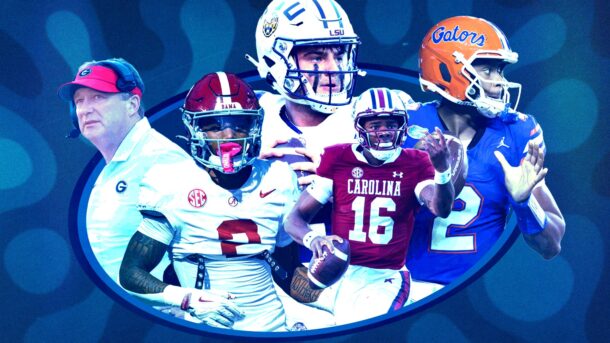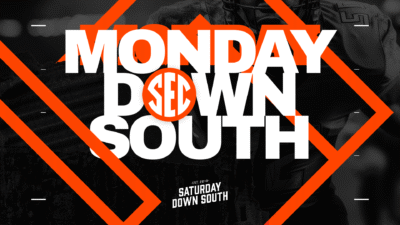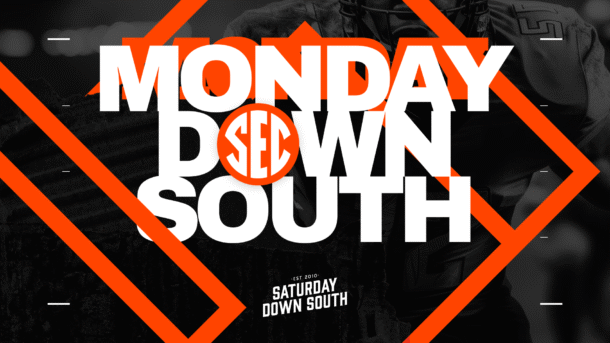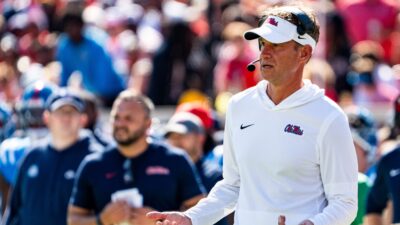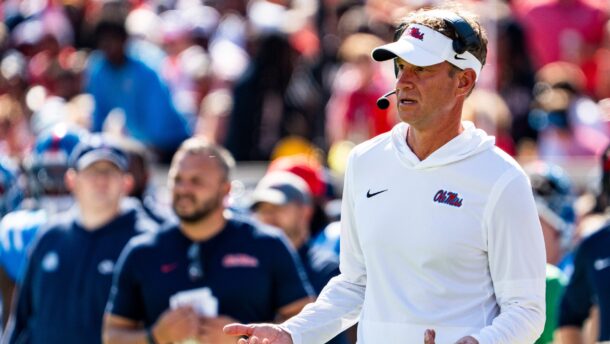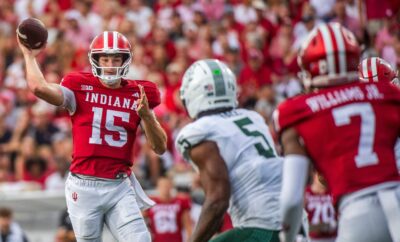How Cadillac Williams and Ronnie Brown became the SEC’s greatest running back duo of all-time

Welcome to G.O.A.T. Week at Saturday Down South. Join us as we go deep with some of the “Greatest of All-Time” from SEC football history, including Bear Bryant, Herschel, the best running back duo, the best starting lineup, the Head Ball Coach and more.
The greatest RB pairing in SEC history almost never happened. Then it lasted longer than anyone could have imagined. In peak form, there was nothing quite like The Ronnie and Cadillac Show.
As Carnell “Cadillac” Williams makes his way up the IMG Academy Fieldhouse stairs, he doesn’t show any obvious signs of someone who tore both patellar tendons in his knees. The broken leg and broken ankle he suffered at Auburn looks like a lifetime ago for the 36-year-old former running back.
With his dri-fit IMG Academy shorts and T-shirt on, Williams looks like he’s still in good enough shape to throw on the pads and break off a few of his signature highlight-reel runs. He quickly shakes that notion off and suggests that might look better than he feels. The wear and tear of his football career caught up to him after 7 years in the NFL.
Williams is still around football every day as the IMG running backs coach in Bradenton, Fla., but his athletic exploits are reserved for the golf course now. It’s a somewhat new hobby. He gets out when he can. An interview with a reporter is his last obligation before enjoying a picturesque 82-degree day on a course just off the Gulf Coast.
There’s plenty of motivation for Williams to improve his golf game (he’s not quite the Cadillac of the golf course yet). A couple times a year, he and his wife and 2 kids take a trip to Atlanta, where they stay with his former partner in crime, Ronnie Brown. Thirteen years after they played their final game at Auburn together, the longtime friends make it a point to hit the golf course together.
“When we see each other, it’s like we haven’t missed a beat,” Brown says.
Cadillac Williams (16) and Ronnie Brown (8) had 24 100-yard rushing games in their career.
Life is different in some ways and similar in others for the former Auburn stars. Both are married with 2 kids, and both are pursuing relatively new career paths.
Williams is entering his fourth year as a coach while Brown is entering his fourth year out of the NFL and what he hopes will be his first year as a licensed senior wealth strategist. Instead of golfing 3 times a week like he did after he retired, Brown is studying for a 6-hour, 250-question securities licensing exam that he’ll take in July. Serving as a financial advisor for young athletes is Brown’s new focus. Well, when he’s not running off to take his sons to baseball/soccer/swimming/Taekwondo.
In between all of that, Brown and Williams still find time to text or call each other every other day. They still talk football, past and current (Williams insists that Brown could easily be a coach with his knowledge of the game). And when they do pair up on the golf course, they still compete, though Brown started playing regularly earlier than Williams so it’s not quite an even playing field yet.
The golf course is the perfect place for them to take a stroll down memory lane. The attention will often shift from the on-the-course competition to the on-the-field competition they began 17 years ago at Auburn, where they became the best running back duo in SEC history.
“Transcendent players, you have to track them all over the field at all times. It just happened for Auburn that at that time, they had two guys you had to track all over the field because once they got the ball in their hands, they could devastate you. Those guys could be 200- or 300-yard rushers if you let them start going off. That’s how the preparation was different.”
Former LSU All-American Marcus Spears
*****
Even the casual college football fan can recall Brown and Williams making history as the first running back duo to be selected in the top 5 of the NFL Draft. They could probably also recall how Brown and Williams fueled Auburn to that undefeated 2004 season, and that they were as dominant of a 1-2 punch as there was in college football.
What many — even diehard Auburn fans — might not know was that the G.O.A.T. of SEC running back duos almost never was.
Brown was widely considered one of the top running back recruits in the 2000 class. The Cartersville, Ga., native grew up a Georgia fan idolizing backs like Garrison Hearst. But the home state Dawgs already added future third-round pick Musa Smith, so Brown narrowed his search to Tennessee and Auburn. The Vols wanted Brown, though they had visions of sticking the 2-way star at linebacker instead of at running back.
“We were fortunate that Tennessee screwed it up,” former Auburn coach Tommy Tuberville told SDS (fittingly, while driving through the Alabama back roads to get to a golf tournament).
Tuberville was desperate to add Brown to his backfield. Tuberville wanted to load up at the position after he arrived at Auburn in 1999 and bluntly told his coaching staff, “We ain’t gonna last long unless we find a running back.”
Auburn offensive coordinator Noel Mazzone put the full-court press on Brown with weekly visits to Cartersville. Brown had an epiphany when he faced the younger brother of then-Auburn quarterback Ben Leard in the state championship, and he remembered after the game thinking “playing at Auburn … that’s big time.”
On getting Brown: “We were fortunate that Tennessee screwed it up.”
On getting Williams: “That was one of the biggest coups in Auburn recruiting history. He was all-world.”
Former Auburn coach Tommy Tuberville
Eventually, Auburn won Brown over and he committed. Upon arrival, though, Brown got his first lesson in waiting his turn.
Tuberville’s need to add running backs in 2000 meant that he also signed JUCO star Rudi Johnson, who got an Auburn-record 324 carries for 1,567 yards en route to SEC Player of the Year honors. Brown was limited to just 10 yards on 6 carries, and ultimately redshirted his freshman season.
Tuberville debated switching Brown to receiver instead of redshirting him. He went so far as to say that Brown had “the best hands of anyone I coached in 40 years” (that includes Michael Irvin). Still, Brown wanted to make it as a running back. That didn’t get any easier the following year when Tuberville signed Williams, aka Mr. Football in Alabama.
As fate would have it, Tennessee screwed that one up, too.
Williams initially committed to the Vols following a visit to Knoxville. He called Tuberville the following Sunday night and delivered the bad news. According to Tuberville, here’s how that call went:
Williams: “Coach, I’ve committed to Coach (Phillip) Fulmer at Tennessee.”
Tuberville: “Carnell, you’ve got to at least look at us.”
Williams: “I’m sticking with my word. I’m going with Coach Fulmer.”
By the end of the conversation, though, Tuberville got Williams to meet the following Thursday. Tuberville brought the entire Auburn coaching staff to see Williams. They put together a pitch that even included photoshopping Williams’ head on to Bo Jackson’s body with him accepting the Heisman Trophy. Impressed, Williams took an official visit to Auburn and switched his commitment to the Tigers.
“That was one of the biggest coups in Auburn recruiting history,” Tuberville said. “He was all-world.”
One reason Tuberville believes Williams signed with Auburn was because they told him he wouldn’t be redshirted as a true freshman. They stuck to their word. With Johnson off to the NFL, Williams finished the 2001 season with team-highs in carries (120) and rushing yards (624).
For Williams, it was the ideal start to his college career. For Brown, however, watching a true freshman leapfrog him on the depth chart wasn’t exactly how he envisioned his career starting. At season’s end, he called his high school coach and debated transferring.
“I just wasn’t playing a lot. I was frustrated. I always thought I was capable of playing and contributing. That was all I wanted to do and I wasn’t getting the opportunity to do that,” Brown said. “I even told coaches that I’d play fullback or that I’d do whatever I needed to do to get on the field … that was just my mentality and the way I approached the game.
“The more I could do, the more opportunities I could create for myself on the field. I was pretty much willing to do anything to be able to do something I loved to do.”
Brown decided to stick around. It didn’t take long for the Auburn coaching staff to appreciate his patience.
*****
Williams admitted he was a bit overconfident after arriving on Auburn’s campus. When he walked into the running back room, reality hit the true freshman.
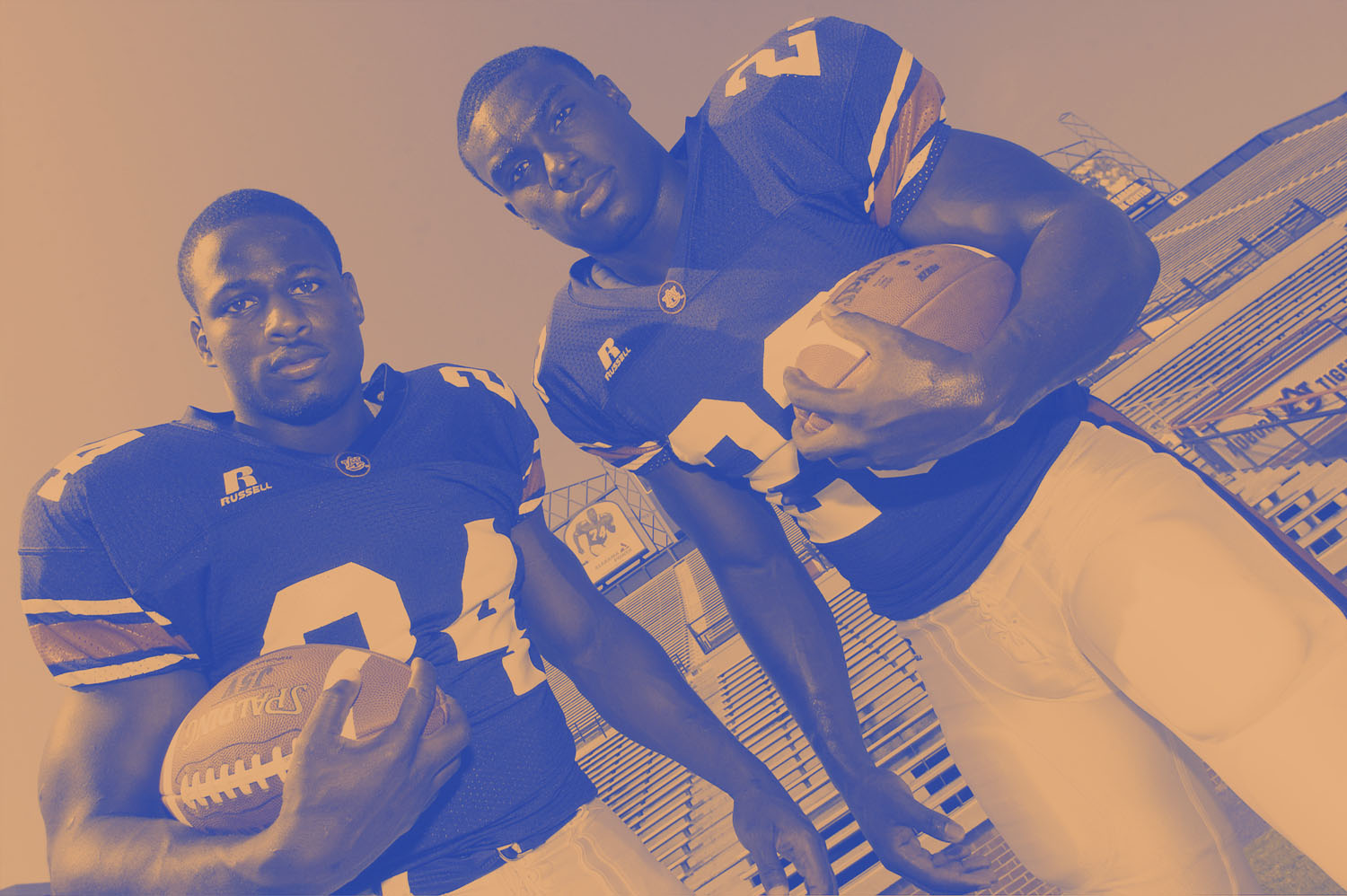
“When I first met (Brown) in person, it was me sizing him up and I was like, ‘Man, maybe I stuck my foot in my mouth on this one,'” Williams said with a laugh.
Williams saw immediately that Brown was the bigger, stronger and faster back. “That’s a tough trio to be behind in,” Williams joked.
Brown, who was 6-1, 222 pounds, always wanted to be shifty like Barry Sanders, but he never forgot a coach telling him that “the quickest path to the end zone was a straight line.”
“Trying to wrap Ronnie up was trying to wrap up a bull,” former LSU All-American defensive end Marcus Spears said.
No instance better illustrated that comparison than when Auburn and Tennessee battled in a top-10 showdown in Knoxville in 2003. In the first 5 minutes of a scoreless game, Brown got a carry up the middle from the Tennessee 9-yard line. After hitting the hole, Brown came head-to-head with Tennessee safety Jason Allen at the 4-yard line.
On that play, the quickest path to the end zone was right through Allen.
“He absolutely flattened him,” Tuberville said.
That was always Tuberville’s favorite Brown highlight because he claimed that Allen, an Alabama native, didn’t even look at Auburn, and instead picked Tennessee because he wanted to go to a “big-time program.” (Ironically enough, Allen was drafted in the first round of the 2006 draft by the Miami Dolphins a year after Brown was. Brown said a few teammates found the picture of Brown plowing through Allen, knocking off his helmet, and put it up in the Dolphins’ locker room. Brown and Allen were teammates for 5 years in Miami, where they became friends and even went out to dinner a few times.)
Brown had the ability to embarrass people who assumed he was pure finesse. He didn’t look like a typical tailback.
Brown and Williams both ran for at least 100 yards in the same game once — in 2004 against Mississippi State. Brown had 147 yards, Williams 122. That combined total (269) also was their highest.
Williams, on the other hand, fit that bill. At 5-11, 204, he prided himself on his vision and quickness to see the hole and break the big play. It made him must-see TV. (That’s also why Tuberville had him returning kicks and punts during his final two seasons.) In fact, many people were probably still getting to their seats when Williams delivered the highlight of his career in the 2003 Iron Bowl.
On the first play from scrimmage, the hole was right of center. Williams got through the line and made one cut to the right, which left the Alabama safety in the dust. Eighty yards later, Williams celebrated an opening-play touchdown. A few hours later, he celebrated a career-high 204 rushing yards and Auburn’s second consecutive Iron Bowl victory.
“That was the play that exemplified a healthy Carnell Williams,” Tuberville said.
Unfortunately, a “healthy Carnell Williams” wasn’t always a given in those first three seasons. Tuberville said that Williams’ greatest strength was his ability to drag defenders, which also wound up being a weakness because as Tuberville said “he just wouldn’t go down.” Two years earlier in the Iron Bowl, Williams’ true freshman season ended when roughly a half dozen Alabama defenders brought him down and landed on his collar bone.
The next time Williams suited up was the 2002 opener at USC. In many ways, it served as a microcosm for the start of Williams’ career.
On the Monday night kickoff game from Los Angeles Memorial Coliseum, Williams came out on fire. He ripped off 92 yards on 14 carries in the first half alone. But in the second half, he and the Tigers ran out of gas. Williams was held to -2 yards on 7 carries, and Auburn took a 24-17 loss to future-Heisman Trophy winner Carson Palmer.
Tuberville was determined to figure out why Williams couldn’t get anything going in the second half.
“On the plane back home, I go up to him and I say, ‘Carnell, what the heck?’ There was nobody on that field in better shape than him,” Tuberville said. “He said, ‘Coach, I made a major mistake in the pregame meal. I didn’t eat. Coach, I was so nervous that I didn’t eat all day.'”
From that point on, Tuberville made sure players ate pregame meals with their position coaches. Cramping didn’t plague Williams that year, but another serious injury did. After rushing for 738 yards and 10 touchdowns in the first half of his sophomore season, Williams broke his leg against Florida. Two seasons at Auburn, two season-ending injuries.
It was a good thing Tuberville didn’t turn Williams’ backup into a receiver. “When I got the opportunity,” Brown said, “it just happened.”
Boy, did it ever.
Brown stepped in against Florida and racked up 217 yards and 3 touchdowns from scrimmage (he had a 54-yard TD catch). As the RB1 in Auburn’s final 6 games, he totaled 831 rushing yards and 11 touchdowns, including a 184-yard performance vs. Penn State en route to Citrus Bowl MVP honors.
After being named second-team All-SEC, Brown earned the right to at least get a higher percentage of the workload alongside a healthy Williams to start 2003. The problem for Brown was that a healthy Williams was dominant. Too dominant. Williams finally got a full season, which proved to be his best. He finished 2003 with 1,307 rushing yards on 241 carries compared to just 446 yards on 95 carries for Brown.
With both players eligible for the NFL Draft following the 2003 season, Tuberville figured his backfield would lose a member, perhaps two. Instead, he got the best surprise of his coaching career.
*****
After the 2003 season, Brown’s patience was finally rewarded. Auburn hired Indiana offensive coordinator Al Borges, who met with Brown soon after he arrived. Borges had some interesting news to share with Brown — he’d get to work in a true 2-back system if he stayed for his senior season.
“My ears perked up,” Brown said.
Borges’ promise pushed Brown, who got a late-third round grade, to hold off on the NFL and return for his senior season. The bigger surprise was that Williams, who got a late-first round grade after his impressive junior season, was also on board with Borges’ 2-back system. The idea of returning with a veteran team with a legitimate chance to win the SEC and compete for a national title appealed to both Auburn backs.
Tuberville still remembers when he got the news. Instead of fighting for the RB1 role, Tuberville was amazed when they told him “we want to help each other” and that they were focused on staying strong all year. It was a dream scenario (the only downside was that after their announcement, future 9-year NFL veteran and 2-time Super Bowl-winning back Brandon Jacobs transferred).
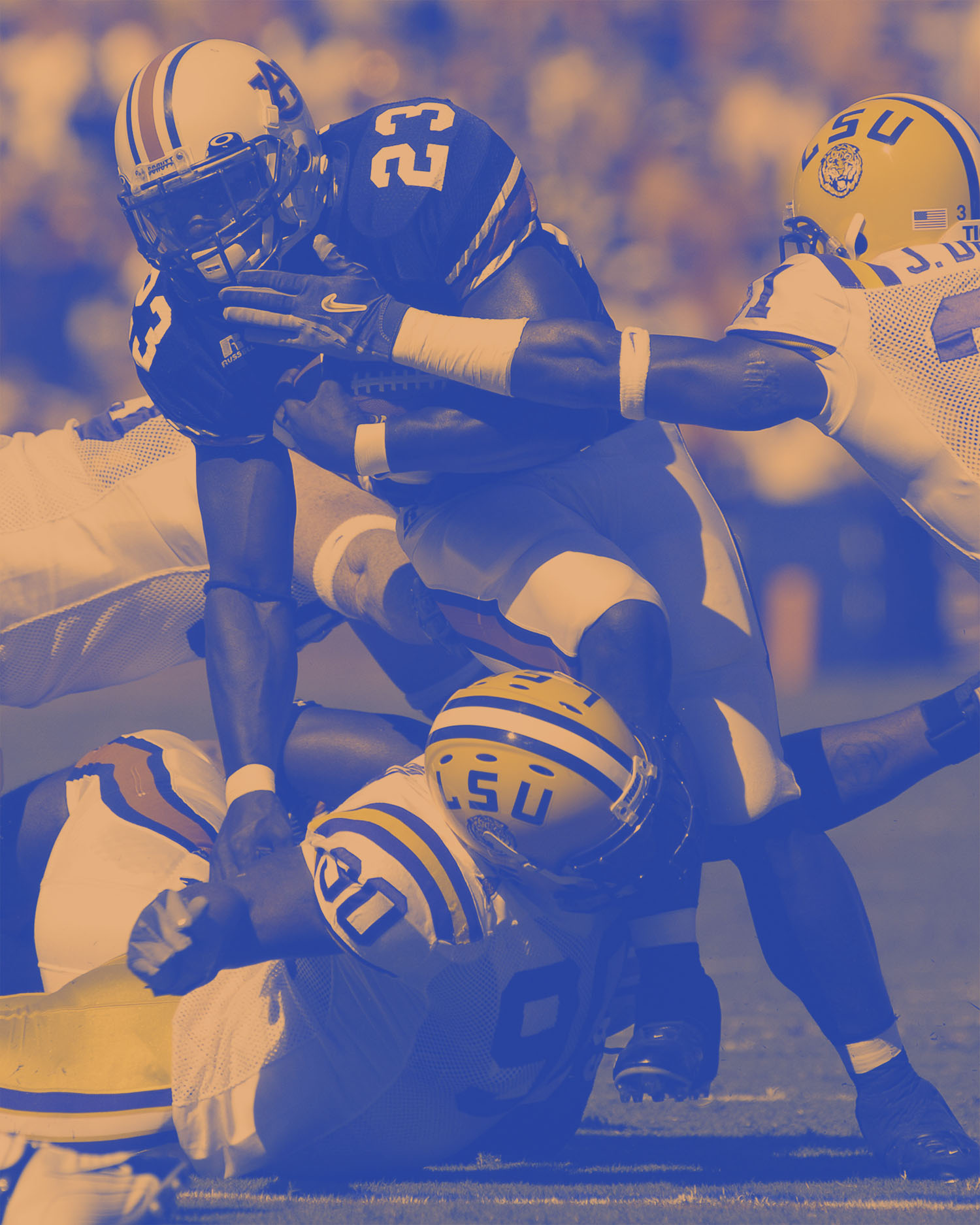
Suddenly, Auburn was a matchup nightmare. Preparing for the variety of skills that Brown and Williams brought to the field proved to be a different kind of challenge. Then-LSU coach Nick Saban had a simple strategy to try and contain the rotating backs — do whatever it takes to prevent them from even sniffing the second level.
“Saban beat that into our brains the whole week,” Spears said.
That strategy proved to be easier to follow in 2003 than 2004. With Williams as the RB1 in 2003, he carried the ball 20 times for 61 yards while Brown got just 7 carries for 30 yards in a blowout loss in Baton Rouge. In 2004, Williams and Brown finished with 75 and 67 rushing yards, respectively, while totaling the exact same amount of carries as the 2003 LSU game.
More important, both Brown and Williams got multiple touches on Auburn’s late game-winning touchdown drive that helped the Tigers knock off No. 5 LSU 10-9.
Even though it was a grind-it-out, defensive struggle, that mid-September game set the tone. Containing Brown and Williams was no small feat.
“Transcendent players, you have to track them all over the field at all times. It just happened for Auburn that at that time, they had two guys you had to track all over the field because once they got the ball in their hands, they could devastate you,” Spears said. “Those guys could be 200- or 300-yard rushers if you let them start going off. That’s how the preparation was different.”
Ronnie Brown’s career-high was 224 yards, against Ole Miss in 2002. Cadillac Williams’ career-high was 204 yards, against Alabama in the 2003 Iron Bowl.
In Auburn’s final 9 games of the 2004 season, only Alabama held Brown and Williams to fewer than 125 combined yards rushing. They totaled a combined 1,983 rushing yards in the 12 games that they suited up together (165 per game). Brown got double-digit carries in 10 games while Williams got between 12-19 carries in all but 3 games. On top of that, Brown was second on the team with 34 catches while Williams’ returning prowess earned him the SEC’s inaugural Special Teams Player of the Year honor.
Did they sacrifice individual numbers? Probably, but Williams still took Jackson’s Auburn rushing touchdown record and Brown was the school’s No. 7 leading rusher despite starting fewer than half of his career games.
But if there were any individual sacrifices, the returns made it all worthwhile. Auburn finished the 2004 season a perfect 13-0, which was exactly what Brown and Williams set out to do when they announced they were returning for their senior seasons. The only thing missing was a chance to play for a national title (don’t ask Tuberville about that one). Still, 2004 was a year for the ages.
“Hands down, my favorite year of football of my life,” Brown said. “We were just able to form that unbreakable bond that transferred over to the football field.”
By the time Brown and Williams finished their Auburn careers, they were no longer the talented tailbacks jockeying for RB1 status. They were road roommates. They were each other’s biggest fans. They were Auburn greats, immortalized for the unselfish approach that fueled the program’s first and only 13-0 season.
They were also first-round NFL prospects.
*****
Tuberville remembered answering a phone call after the 2004 season and hearing a familiar voice. It was Saban, and he needed advice.
Saban was the first-year coach of the Miami Dolphins. The former LSU coach had a decision to make with the No. 2 pick in the 2005 NFL Draft. He was hoping Tuberville would make it for him.
“(Saban) says listen, ‘I’ve gotta get some help. Which one would you take?'” Tuberville said. “I told him, ‘You’re not gonna go wrong with either one of ’em.'”
Saban wasn’t the only coach who studied up on Brown and Williams. The former Auburn backs got the full rundown ahead of the draft. Their maturity wasn’t hard to spot in their pre-draft interviews with NFL teams.
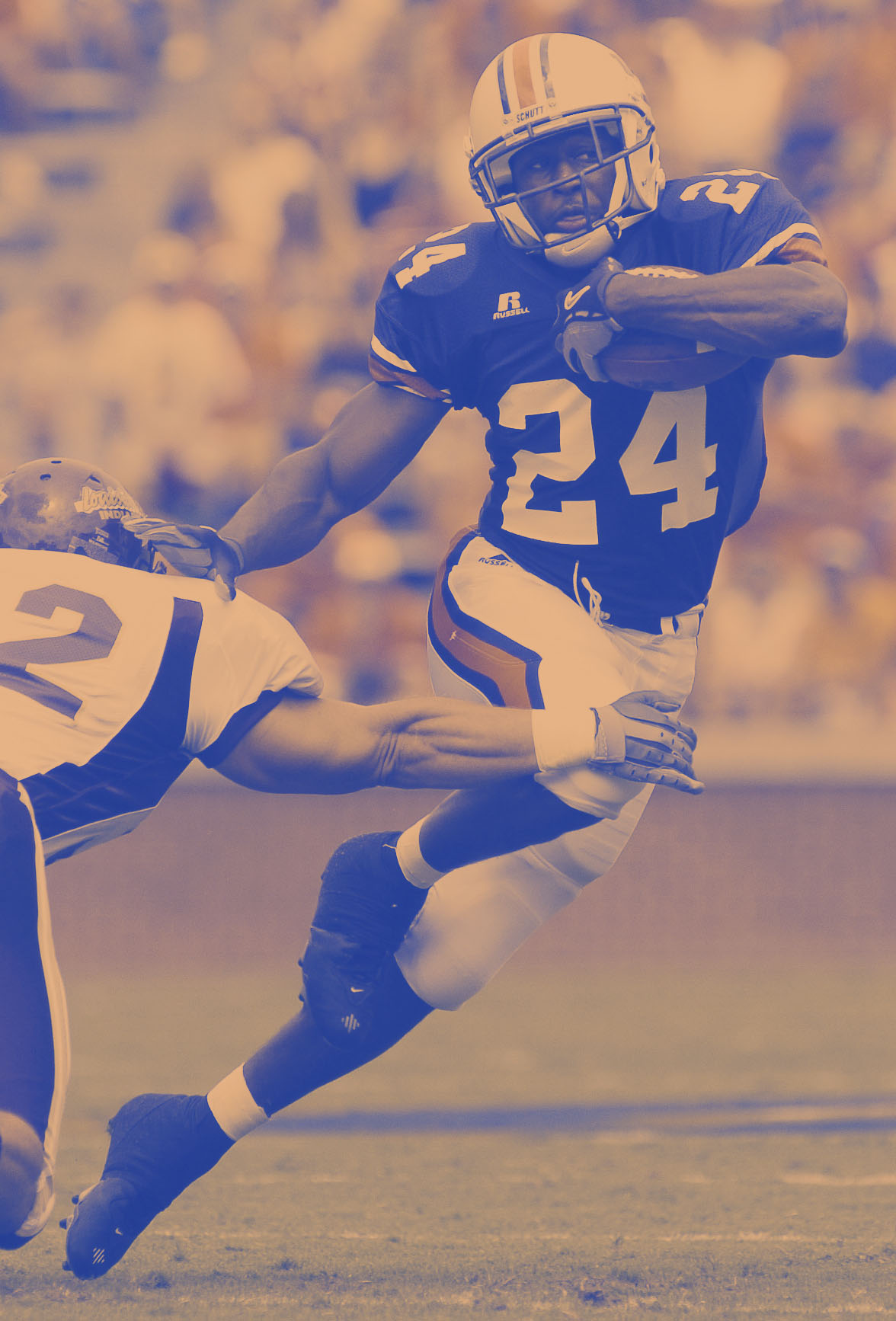
“I’ve been around a lot of first-round picks,” Tuberville said, “and I’ve never gotten feedback like what we got on those 2 kids.”
Both Brown and Williams were invited to attend the 2005 NFL Draft in New York. That was the first sign that they were going to be selected high, though both just assumed they were along for the ride. Brown actually told his agent that he didn’t want to travel to NYC because he didn’t want to be the last guy in the green room. Eventually, he caved.
Little did he know that he and his former running mate were about to make some more history.
NFL commissioner Paul Tagliabue stepped to the Radio City Music Hall podium and announced, “with the second selection of the 2005 NFL Draft, the Miami Dolphins select Ronnie Brown, running back, Auburn.”
Three picks later, Tagliabue did something no NFL commissioner had done. For the second time in the first 5 picks, Tagliabue announced the words “running back, Auburn.” The Tampa Bay Buccaneers took the guy who earned the nickname “Cadillac.”
That meant for the first time in NFL history, two running backs from the same backfield went in the top 5 of the NFL Draft. Before that, the earliest two running backs from the same school came off the board was in 1987 when Texas A&M’s Roger Vick and Rod Bernstine were selected No. 21 and No. 24, respectively.
How fitting it was that Brown and Williams set a new standard after they redefined the position in their final season at Auburn.
“Afterwards, it was pretty cool to get on the phone and be like, ‘Man, wow. Two and 5?'” Williams said.
To this day, no running back duo has even gone in the top 20.
*****
It’s been debated before and it’ll be debated again. But I’ve never had the chance to give my 2 cents, so hear me out.
I ranked the top 5 running back duos in SEC history, though I might’ve done so in a way that’s different from what you’re used to. To me, if you’re going to rank duos, you have to evaluate how they performed together as a duo. Average yards from scrimmage are huge. Doing things besides just running the ball was also important in my evaluation.
To a certain extent, I even value team success. Great duos take their team to new heights, and though two players aren’t the only factors as to whether their team wins, it should certainly count for something. After all, that’s why running back duos are duos in the first place. They might sacrifice some of their workload if it means providing the more efficient, versatile offense.
So let the debate continue:
5. Derrick Henry and T.J. Yeldon, Alabama
They were sort of a 1-year wonder as a true duo, but the 2014 season was impressive enough to earn a spot on this list. They combined for 366 carries, 1,969 rushing yards and 22 rushing scores. They were separated by just 22 rushes and 11 rushing yards while finishing with the same amount of rushing touchdowns. An average of 169.4 scrimmage yards per game for the SEC champs and Playoff participants was impressive, though not quite as impressive as the duos who ranked ahead of them.
4. Mark Ingram and Trent Richardson, Alabama
In 2009 and 2010, there wasn’t a better running back duo in college football. Ingram won the 2009 Heisman Trophy while Richardson ran for 751 yards and 8 touchdowns as a freshman. They combined for 204.9 yards from scrimmage per contest en route to leading Alabama to a perfect season.
So why didn’t they top this list? Well, part of it was that Ingram was clearly RB1 that year (he finished with almost double the carries) and the 2010 season was the year that Alabama fans try to forget. Ingram had early-season knee surgery and returned, but he only finished with 875 rushing yards (a little more than half his 2009 total) in 11 games while Richardson also only appeared in 11 games and finished with 700 rushing yards. And obviously, that was part of Alabama’s unfathomable 5-3 mark in conference play (10-3 overall). Still, 2 seasons with a combined 4,992 yards from scrimmage ain’t too shabby.
3. Darren McFadden and Felix Jones, Arkansas
One could make an argument that McFadden and Jones deserved to top this list. They had 3 seasons together in Fayetteville, where they combined for 8,294 yards from scrimmage and 66 touchdowns. That doesn’t include Jones’ exploits as one of the best returners in SEC history. The Wildhog formation allowed for versatility out of the backfield that few teams have ever had. In their final seasons, they combined for an insane 256.3 yards from scrimmage per game and they finished their careers with the second most career rushing yards by a duo before they became first-round picks in the 2008 NFL Draft.
But I have a couple of reasons why I didn’t put them at No. 1. To me, a duo means a relatively shared workload. McFadden had 192 more carries than Jones in that prolific junior year (which still only yielded a 4-4 SEC record, by the way). As efficient as Jones was, he only averaged roughly 12 touches from scrimmage per game in his final 2 seasons. That’s not a knock on Jones. He was extraordinary. But we’re talking about true duos here, and the usage numbers don’t quite reflect that. Don’t get it twisted, though. I’d take McFadden and Jones in my backfield all day, any day.
2. Nick Chubb and Sony Michel, Georgia
I know what you’re thinking. How can the most prolific duo in FBS history not even be considered the No. 1 duo in the SEC? They combined for 9,364 yards from scrimmage and 87 touchdowns. Originally, it was Chubb’s injury that opened the door for Michel to shine in 2015. They then operated as a true duo in their final 2 seasons with a combined 4,903 yards from scrimmage. Even the running back factory that is Georgia might not produce a duo that prolific ever again.
So here’s why they didn’t get the No. 1 spot. I’d argue that at their peak — the 2017 season — they weren’t quite as dominant as the No. 1 duo. They averaged 186.2 yards from scrimmage per contest, which is still remarkable, but not as productive as some of the other duos on this list. Part of that could’ve been because of how many blowouts they played in as seniors — that opened the door for D’Andre Swift to rack up 618 yards as the team’s No. 3 — and that they weren’t regularly involved in the passing game (I know Michel was capable, but they combined for just 13 catches and 126 yards in 15 games in 2017).
Chubb and Michel were the heart and soul of Georgia’s incredible runner-up season. In my opinion, they were the closest thing to my No. 1 selection, though they didn’t quite check all the boxes that they did.
1. Ronnie Brown and Carnell “Cadillac” Williams, Auburn
Yes, the G.O.A.T. of SEC running back duos was Auburn’s incredible 1-2 punch back in 2000-04. They had somewhat similar career arcs as Chubb and Michel with Williams suffering the serious injury that allowed for Brown to emerge (Brown ran for 831 yards and 11 touchdowns in the final 6 games of the 2002 season after Williams broke his leg against Florida). They didn’t really become a true duo until they both surprisingly returned for their senior seasons, which was in part because of new offensive coordinator Al Borges’ desire to use a 2-back system.
Yeah, that 2004 season was something else. As a true backfield duo, Brown and Williams put that offense on their backs. Besides rushing for a combined 2,078 yards with 20 touchdowns, they also had a combined 55 catches for 465 yards (203.5 yards from scrimmage per game). Brown was actually second on the team in catches. And just in case that wasn’t enough, Williams was the SEC Special Teams Player of the Year. They truly shared the workload — go back and look at how even it was in late-game situations — for a team that went 13-0 and was robbed of playing for a national title.
If there’s a trump card, it’s that they became the first running back duo ever to go off the board in the top 5 of the same NFL draft (Nick Saban actually had the No. 2 overall pick in his first year with the Dolphins and called Tommy Tuberville to ask him which back he should take; he took Brown). Brown and Williams paved the way for other SEC running back duos. Without a doubt, they earned the right to be called “the G.O.A.T.”
When Brown and Williams talk now, their unprecedented draft feat is still a topic of conversation. Williams finds that himself referencing his accomplishments more now that he has kids. Life is certainly different for both.
The thing that hasn’t changed is their bond.
Seventeen years ago, they were probably better bets to wind up enemies than friends. They’re a lifetime removed from being freshman running backs who sized up each other. If there was any beef or jealousy, they learned how to move past it.
“The relationship was genuine. It wasn’t forced, nobody told us, ‘Y’all need to talk. Y’all need to hang out,'” Brown said. “It was just natural. We got to know one another, learn about each other’s backgrounds and we were somewhat similar.”
Williams’ only regret is that he didn’t embrace truly working with Brown sooner. Without Brown sharing the backfield, Williams might not have become a top-5 pick. Maybe he wouldn’t have won NFL Offensive Rookie of the Year and played 7 years in the NFL if he took a few more hits in his college career.
Brown has the NFL bragging rights over Williams because he had the 10-year career and he finished with more yards. Who knows how many extra carries Brown had in his legs because he didn’t get 30 touches per game at Auburn.
They needed each other. That’s still the case.
“Watching him, the way he worked, the things he does with his family, it helped me become a better man, a better person all around,” Williams said. “Ronnie Brown is truly a lifelong friend that I have in my corner.”
That relationship fueled what many will argue was the greatest running back duo in SEC history. Their uncharted path paved the way for many of the great SEC backfield duos that followed them. Tuberville had flashbacks this past year while calling Georgia games with Sony Michel and Nick Chubb. Others might have seen shades of Brown and Williams when Arkansas had Darren McFadden and Felix Jones.
The G.O.A.T. of SEC running back duos debate will never cease. Ask Williams and he’ll tell you there’s a clear answer.
“Hey,” Williams said. “I feel like we’re the best of all-time. I’m taking it to my grave.”
All photos courtesy of Auburn Athletics / Todd J. Van Emst (@fototodd)
PREVIOUSLY IN G.O.A.T. WEEK:
Gift of a legend: The life and legacy of Bear Bryant
Herschel Walker: The greatest running back I never saw
Connor O'Gara is the senior national columnist for Saturday Down South. He's a member of the Football Writers Association of America. After spending his entire life living in B1G country, he moved to the South in 2015.
